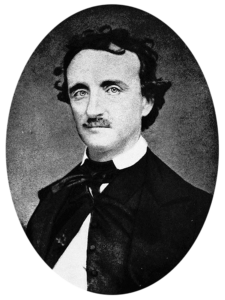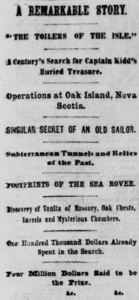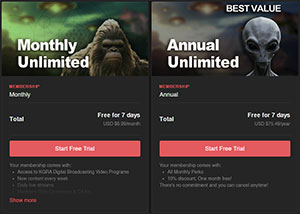The True Story of Oak Island and Arcadia Part II
By Cort Lindahl
William Alexander, 1st Earl of Stirling’s involvement in the fictional story of “Arcadia” by Philip Sidney appears to be the source of the original Oak Island Treasure story. Why would this story be applied to this mystery? What further evidence is there to support this notion? Any examination will compel us to consider one of two possible scenarios as to how this happened. Either the treasure at Oak Island was contrived to fit the fiction of Arcadia, or the fictional story refers to a real treasure they knew was buried in the Money Pit at Oak Island. There are many factors that may compel one to take either side of this argument. There are no references beyond the name of the work “Arcadia” and its relation to “Acadia” or Nova Scotia in the text of the work. The entire fictional story takes place in the province of Arcadia in Greece. So, this metaphor may be interpreted as meaning Nova Scotia, though this is not stated outright. The fact that Alexander had a hand in editing it later may fuel the idea he did this intentionally to lead one to the similarities in the description of the treasure and that deposited in the Money Pit. Alternately, this story may have been copied in any intentional ploy or ruse that involved making others believe there was a treasure on Oak Island.
It would be somewhat easier to suppose that the Money Pit was there and somehow Sidney, his sister Mary Herbert Countess of Pembroke, and then William Alexander had added this information somewhere along the line as a hidden message within this literary work. Again, this could be used to infer a real or contrived treasure story. It does appear that Alexander had edited “Arcadia” at around the time he was also awarded the Baronetcies of Nova Scotia in 1621. It is also clear that his son William Alexander, “the younger,” had actually gone to Port Royal, Nova Scotia, today and created a settlement known as the Habitation. After a period of about ten years, the Scottish colonists were forced to leave as the region had officially come under French control.
Given this, there is some speculation that members of the Alexander family had stayed in Nova Scotia at this time and were allowed to retain their lands. This is indeed possible given the scheme of the real history of the time. William Alexander, 1st Earl of Stirling, and his family were forever closely tied to the fortunes of Charles I and II. William had served as a tutor for James I’s son Henry and Charles, the future king. Charles was eventually beheaded for his lack of cooperation with the Parliamentarian government and, in part, because of his Catholic faith. The date range of these happenings in Nova Scotia and Charles’ beheadings are close to the same time. Charles’ Catholicism and descent from Mary Queen of Scots would have also given him a close association with the French Monarchy at that time, who were, in effect his distant cousins. This would, of course, be the same French regime that had taken Acadia back and may have found reason to value the former close allies of Charles I. These facts may contribute to the reasons the following information is true. Through time, in the later Jacobite cause, we see the exiled Scottish nobles James II, III, and Bonnie Prince Charlie spending their exile at the summer palace of Louis XV at St. Germaine en Laye near Paris. The fact that the French allied themselves with the Americans in the Revolution also jives with the fact that the Jacobites (adherents to the exiled kings) had played a significant hidden role in creating the United States.
During the time of French control of Acadia after the expulsion of the Scottish Colony at Port Royal, there are records of members of the Alexander family remaining in Nova Scotia on what is described as one of their estates there. Amazingly, there are records of an Alexander Alexander living in New Ross, Nova Scotia, in 1654. Though some question these records, we will consider them here. Throughout the history of the Alexander family, there were many members named Alexander Alexander!
This amazing association also fits directly into the mythology or truth of Oak Island. New Ross is a site that has been pointed to as including “Sinclair’s Castle.” The site appears today as some dry-laid stone foundations and other various associated features. This site near New Ross is speculated to have been built by Henry Sinclair, the Earl of Orkney, who many suspect of having made an early off-the-record voyage to the Maritime region. We are seeing here with genealogical proof that the Alexander family may be the people who built the site that many attribute to Henry Sinclair. According to this source, this property was their domain, and the French had allowed them to maintain ownership and occupancy. This would not mark the first time that members of the Sinclair family were given credit for or “blamed” for things members of the Alexander family had actually done. It is possible the whole story of New Ross and its legacy are connected to William Alexander’s influence on Sidney’s “Arcadia.”

Edgar Allan Poe
This is indeed possible, and if the Alexanders really did live at New Ross, it may explain why the story of the Money Pit was included in “Arcadia” later. In past works, this author has speculated as to the involvement of interests of the United States in the Money Pit legend. When England regained Acadia from the French General Lawrence in about 1710, many colonists from Maine and New England were offered land in Nova Scotia. When the American Revolution occurred, many of these men returned to the colonies to fight for the American cause. Amazingly, these people were allowed to retain their property in Nova Scotia after the war. This included many well-known families whose members had fought as officers in the Revolutionary War. This would include members of the Allan (Edgar Allan Poe’s relative), Longfellow, and Delano (Roosevelt) families. These men were also members of the Society of the Cincinnati, comprised of former military officers who had fought for the United States, including colonial, French, and German men. This organization would back many democratic movements during this period of history, including the French Revolution. It also appears they were scheming to make Nova Scotia and the other Maritime provinces part of the United States. As this story progresses, we will see none other than the influence of the Alexander family of the United States having a large effect on the Oak Island question and other similar mysteries there.
All the subsequent members of the Alexander family discussed here descended from William Alexander, 1st Earl of Stirling, or one of his brothers. Many of them emigrated to the United States during the seventeenth century, including John and Philip II Alexander who were given land grants that include what is today Alexandria, Virginia, and most of the portion of land that would become the old District of Columbia south of the Potomac River. One is left to wonder if Philip was indeed named for Philip Sidney. Here again, we see Alexander intimately involved in the creation of a city that would also supply us with many mysteries and a strange street plan that also suggests many metaphors and classic myths. Given what we are learning here, we see how the Arcadian mythos is included in the imagery of the Washington District of Columbia.
The City of Alexandria, Virginia, is named for these two men. This area was part of what was termed the Truro Parish, named for Truro Cornwall, which also included many illustrious Northern Virginia families such as the Lees, Masons, Moncures, and others. During this time, the Alexanders were closely associated with members of the Washington family, with one female descendant marrying into a portion of the Lewis family, making George Washington’s sister her mother-in-law. It is of some interest that Truro Parish shares the same name as one of the major organizations that later would be formed to recover the Oak Island Treasure.
In past works, I had speculated that the Lee family was aware of Oak Island via my interpretation of the hexagonal Ft. Carrol built by Robert E. Lee while he was a Colonel in the U.S. Army (ca. 1849-50). There are many strange connections between the American colonies and Nova Scotia, and at this point, this was simply speculation on my part. Subsequent evidence may suggest this is true. It does appear that there were plans for Nova Scotia to become part of the United States of America after the Revolutionary War, and the entire saga of Oak Island may have been part of that plan. Amazingly, another hexagonal axis, Portus of Rome, also “points to” Oak Island and Ft. Carroll in a single azimuth on the globe. The Port of Portus was built by Emperor Trajan, and this port was where both the Heliopolitan Obelisk of St. Peter’s Square and the much-vaunted Temple Treasure arrived in Rome. Portus had just been rediscovered when Ft. Carroll was built and may have even inspired its hexagonal design. Ft. Carroll “points to” the Lee’s Arlington Estate to the southwest and to the northeast, the opposite direction transects the globe to reach the Dome of the Rock on the Temple Mount in Jerusalem, which was, of course, the original location of the Temple Treasure.
(Word Search “General Lee Oak Island” and see what pops up).

1866 NY Herald Headline
Another man named William Alexander is included in the American descendants of the Alexanders of Scotland. William had branched off from his Virginia relatives and was living in Basking Ridge, New Jersey, at the time of the Revolutionary War. William was directly related to John and Philip Alexander, as well as Alexander of New Ross, Nova Scotia, mentioned earlier. William Alexander became a General in the American Army during the Revolutionary War and worked for a short span under the command of General Charles Lee. He took part in the first defense of New York and continued throughout the war to have an exemplary record in combat. He was, of course, a distant relative of George Washington via the Lewis family, and the two men may have been aware of their relation in this manner.
Interestingly, after the war, General Alexander returned to England and attempted to regain the title of Earl of Stirling that he felt was due him as part of his family legacy. There are other cases of Americans retaining their titles after the Revolution. Of course, if Alexander could regain this title, it would also give him de facto “ownership” of Nova Scotia and huge tracts of Long Island. General Alexander was awarded his title by the Scottish Parliament at that time, but the English House of Lords denied his application to retain and use this title. Despite this, Alexander refused to accept their decision and continued to use the title “Lord Stirling.” Here, we have a continued rationale for why there was an effort involving the Society of the Cincinnati after the war to take Nova Scotia and make it part of the United States. General Alexander had attempted to make a case that he was due compensation or control of these regions, which could easily lead to them eventually being considered American territory. Here again, we see the specter of William Alexander, Philip Sidney, and the story of the Oak Island Money pit included in the text of the literary work “Arcadia.” This era of General Alexander is also the time during which the entire Money Pit mystery was first exposed to the public. Could General Alexander have been behind the entire mystery?
The story of how Alexander attempted to regain his title illustrates the fact that he was likely privy to the truth of Oak Island and the Money pit, possibly via a family legacy or fraternity. Had he shared this information with any of his other early American relatives, like the Washingtons and Lewises, or extended it to close friends like the Lees? Also, note the Lewis’ close relation to Thomas Jefferson and the Beale family. It may be that Alexander’s Society of the Cincinnati compatriots, including those in Nova Scotia, had helped to arrange what we know of as the Money Pit today.
The fact that Alexander had attempted to regain his title, along with the presence of so many people in Nova Scotia who had fought for the Americans in the war, does seem to call into question the legitimacy of there being any actual treasure at the Money Pit at Oak Island. At least at first, this may be discerned. What is possible is that the 1634 occupants named Alexander at New Ross had somehow constructed the Money Pit, installed a treasure in a vault below it, and left the layers of logs and 90 ft. stone to be found later. This may also fit in with the real original story of people who had been awarded lots on the Island having actually found the Money Pit instead of the original folklore of three young men seeing lights on the island one night and subsequently finding the Money Pit. It is possible that these early Nova Scotian Alexanders of New Ross had also recovered riches from the free gold deposits of the Gold River, which is adjacent to New Ross.
The fact remains that no one really knows the truth as to what this all means. This is, however, a great deal of additional info that we must digest and game out to see the possibilities. The fact that Alexander’s and American cause was so closely associated with the French during this era also adds another layer of possible misunderstandings. Given all of this, it is starting to look more and more as if one of three possibilities has already happened. If something was at the Money Pit, it had been recovered by the earlier Alexander’s of New Ross who were likely aware of the treasure story in “Arcadia.” Alternately, they had crafted the entire legend of the Money Pit as a Masonic initiation quest of some kind or had done it to confound the new English rulers of Nova Scotia. They may have been crafting a folklore that informed one of the true ownership and heritage of Nova Scotia. It is clear that groups like the Wilton Writer’s Circle of Mary Sidney, the Academy of Arcadia of the Vatican, and the Society of the Cincinnati had involved themselves in producing representational art and literature that supported their philosophies and values.

Many artists over centuries and across continents have been inspired by this concept of “Arcadia,” the ideal, of a pastoral paradise, as we see in this work from American artist Thomas Cole circa 1838.
The settlement of New Ross and Oak Island are also in a region that saw a gold rush at about the same time this was happening in California (mid-nineteenth century). The headwaters of the Gold River itself begin near New Ross, and the River empties into the Atlantic Ocean just a few miles north of Oak Island. It may also be possible that the early Alexanders of Nova Scotia had been aware of this gold deposit and had been taking advantage of it for many years, leading us to the Oak Island Money Pit that was created to either stash their loot or to cover up the fact that they were recovering gold there in the first place. The original William Alexander of Stirling was also highly involved in mining in Scotland.
The recovery of gold to be used by the Americans in the Revolution is also a distinct possibility and may serve as further rationale as to why there is no remaining treasure at Oak Island. Though Presbyterian, the Alexanders had always been staunch supporters of the beheaded and exiled Catholic Stewart Kings of Scotland and England, so it would be no surprise that any gold deposit in Nova Scotia would have gone to support the Jacobite and Cavalier causes that also seemed to have shaped this period of history in Virginia and New England.
This information supplies a strong rationale with no “smoking gun,” saying there is nothing at Oak Island. It reveals a strong value of American interests in the mystery of the Money Pit and the land of Nova Scotia itself.
The influence of Philip Sidney and William Alexander in this story also has a direct tie to the Menteith Earls and the concept of “Sancto Claro.” Though Alexander has a very direct connection to the development of the Stewart family and Robert the Bruce from a genealogical perspective, Sidney possesses a link to Walter Fitzalan from the time he spent in Wales with the Count of Pembroke prior to his exile in Brittany.
Many have speculated about the involvement of coded portions of the First Folio of Shakespeare that had been funded by Philip Sidney’s nephews, the sons of Mary Sidney, Countess of Pembroke. As it turns out, the mythology of the Money Pit is also closely related to a Scottish author and poet, William Alexander, 1st Earl of Stirling, who had edited a work that both Mary Countess of Pembroke and their uncle Philip Sidney had both had a hand in creating. Later, it truly appears that “Arcadia” had been edited by William, subsequently gaining its associations with the Money Pit. A resounding “why” does not fully answer the riddle of the Money Pit but does infer a high degree of skullduggery in whatever its true purpose was. There are too many coincidences along the way for us to assume that the entire thing was not either a misinterpreted Masonic quest or had been covering up the recovery of Gold or some other enterprise or industry at Oak Island. In the end, we are now forced to consider that the literary inspiration for The Money Pit was not Sir Francis Bacon but Philip Sidney, who died when Bacon was twelve.
Cort Lindahl is a researcher and author who has appeared as a history expert on various television shows, including Oak Island. Find more of Cort’s work at survivalcell.blogspot.com.





 KGRA Digital Broadcasting
KGRA Digital Broadcasting KGRA Digital Broadcasting
KGRA Digital Broadcasting